#ness has ceased to exist in this current game :(
Explore tagged Tumblr posts
Text
Real footage of me reading the 285 leaks

Kjjgasdjkls don’t mind me, i’m just gloating a bit bc one of my long time theories is now canon!!
And omfggggg it’s exactly as imagined!!!
(…So far)



#AHAAAAAAAHA I WAS RIIIIGHT#I GOT THIS ONE RIGHT#FINALLY!!#don’t look at my ness development theories tho…………….#ness has ceased to exist in this current game :(#he’ll def get a rebirth in the word cup arc#i’m manifesting it.#bllk#blue lock#michael kaiser#isagi yoichi#kaisagi#bllk leaks#blue lock 285#bllk 285
32 notes
·
View notes
Text
A story for an aroace person aka me world lore part 1 ig :p

So to recap, I've had thought about a story with an aroace mc who gets reincarnated into an otome game with her best friend and she is the original mc and her best friend is the original villainess and both of them have no idea if the other is also present in the otome game with her.
This though has been stuck with me for over TWO years so I had a lot of time for the world building part which I might change cuz I'm indecisive as hell when it comes to this.
So now this is the current lore of the otome game world which I should REALLY come up with a name for the said world :'D
××××××××××××××××××××××××××××××××××××××××
In the beginning, there was nothing. It's simple really, there was nothing.
No planets.
No moons.
No suns.
No stars.
No galaxies.
No universe.
Simply nothing...but
There's always a but...
Simply nothing but an entity who was quite bored with there being nothing. So what does 'it' do? Why, create something of course!
Nothing will cease to exist if one where to make something right?
But how can you create something out of nothing?
That just sounds absorbed!
That didn't matter to 'it' all it wanted was some company no matter what kind it was.
'it' wanted company not because 'it' was lonely no no no. 'it' wanted company simply for the fact that "it" wanted change. 'it' wanted to be entertained. 'it' didn't want to stay bored again.
So 'it' started to create the planets... moons... stars... galaxies and so much more.'it' had something to do so 'it' just created more and more and soon the a minor part of the empty nothing-ness was filled with more galaxies than it could be counted.
'it' only created things in the minor part of the nothing-ness to know that it would be easy to wipe out everything if the things 'it' created was not entertaining to 'it'.
But luckily 'it' was satisfied with what 'it' had created. So, the stars shined, the planets and the moons coexisted and most importantly 'it' was entertained.
'it' came to love what 'it' had created and would often just spent a lot of time just observing the planets, the moons, the stars and the galaxies and many other things. It was fun to know that what 'it' had created was capable of change if 'it' left it alone and simply just observed.
'it' would often talk to the things 'it' had created even if they couldn't talk back to 'it'.
"did you know that I created you guys just because I was bored?" 'it' said to a star.
The star did nothing but shine brightly.
"oh! But that doesn't mean I don't care about you guys! Even though you can't talk it's nice to have someone who can just listen you know that right?"
Still nothing. Nothing but the sound of 'it' own voice and then silence
"you know what fascinates me? Change! It's so fun to see change happen Infront of my eyes. It fascinates me that what I created can change without needing me."
All 'it' got was silence.
"Well just so you know even if anyone of you change to the point where you seem different from how you were once, doesn't mean I won't recognize you. It just goes to show how much you've grown since you once we're"
Nothing but silence follows.
**sighs*Well looks like it's time for me to go now my dear but fear not as I'll be back soon!...well as soon as I see fit that is"
With that 'it' moves away form one of many stars that shine brightly in the nothin-ness.
'it''s entertainment didn't last long or so it seemed at least, neither less 'it' grew bored of the things 'it' had created.
Sure 'it' could talk to them but they never replied to 'it'. They just listened. 'it' wanted something that could talk to 'it'. So that's what 'it' tried to create next.
But creating a thing was that could talk was proven to be a bit challenging that what 'it' had created so far. 'it' grew frustrated as the time passed and grew more and more impatient, until 'it' finally snapped "ugh! Why is this so hard!? Why can't I create something that can talk!? It shouldn't be that hard I can talk just fine-"
Just then a new feeling over came 'it'
××××××××××××××××××××××××××××××××××××××××
Welp that's of for the lore part for now lol
I didn't have motivation to write the next part of the story so I wrote the lore of how the 'world' came to be XD
Hope you enjoyed.
Btw I found the copy in which I wrote the story lol
I wrote 40+ pages and will most likely write more. Mostly cuz like not even 25% of the story is written in the copy.
And even less is posted in here.
The only problem is that I've made the characters designs of a lot of characters which will most likely be a part of the story no matter how big or small part that are in gacha cuz I suck at drawing TT
Just hope I can do my best on writing the stor!!!
#aroace#aromantic#asexual#original character#original story#original stuff#lore#world building#aromantic asexual#world lore#the start of it all#the start of something
4 notes
·
View notes
Note
i apoligze for this in advance but idk who else to ask. so i’m attracted to women like 92% of the time but i’ve been dating a guy for a few months now. it’s not super serious yet but i still find myself feeling sad about never having had a gf/worrying i never will and just feeling like a bad queer. i KNOW that it’s terribly biphobic of me to think that if i a femme enby date a cis dude i’m not queer enough. but i also cant get past it no matter how many times i look at these ugly brain thoughts
first of all: you never have to apologise for sending me stuff like this. it is a known facet of my tumblr, and while i know i am hardly around at all, i do periodically check my inbox and am never angry or annoyed or any other negative emotion to see people reaching out for help/advice. i don’t always have the mental bandwidth to respond, but i am only ever glad that people still consider this a safe place to reach out to.
there are a couple of things i want to address here! in no particular order:
you are not a future teller or a psychic, no matter how much your worries and anxieties insist that they know what is coming. the fact that you are in a relationship with a man in this moment has no bearing on what relationships you may find yourself in, in the future. the fact that the person you are dating currently identifies as a man is no guarantee that they will always identify that way, even! you could be with them for the next couple of weeks or for the rest of your life and there are a million permutations in between and around those two options.
what i’m saying is - obsessing over things you might not do in the future because of things you are doing now is a game that nobody wins. you have no guarantees of what the future is going to hold - you can make decisions now based on what you want and/or expect the future to hold, but stressing about the path not taken means that you’re going to spend all your time straining to see that path and like, walk into a big boulder in the path you’re actually on or something. currently, you’re not even stressing about the fork in the road that you came across. you’re on a single path, and you’re worrying about a path you haven’t come across yet, which may or may not diverge from the path that you’re on, or might be in a different forest entirely and and and- at some point you gotta love the path you’re on and take in the scenery, my darling.
which, incidentally - this path? not incompatible with queerness. and i know you know this, but feeling it can be! so hard! so i am here to remind and reassure you that - queerness is not an action. the nature of identity is not things that you do, it is the person that you are. you do not cease to be non-binary because your outfit changes - your fashion choices are simply a way of expressing your non-binary-ness, and they are not the only way, and if you are not using fashion to express your enbyness then that doesn’t make you not enby. you don’t stop being enby when there is no one there to look at you and make external judgements about your gender, and you do not stop being queer because you are a femme-adjacent person dating a cis dude.
queerness is a thing that you are. you can take actions that express that queerness more clearly to outside observation, but outside observation does not change the fact of your queerness. i will not deny that it can make it easier to participate in community, because community is in part made up of particular signs that individuals recognise in each other and gravitate towards - but who you date is only one such sign. i’m a lesbian who hasn’t dated anyone for over half a decade - am i less queer because i have not hooked up with a chick in that time? i am not. if i fuck a dude am i less of a lesbian? idk man that depends on how i feel about fucking a dude. am i romantically and sexually attracted to the dude, or was his dick just inside me? what if he just uses his fingers? i feel like i could feasibly have sex with a cis man out of sheer curiosity and still be a lesbian, sure, but what if there’s a single man that just perfectly meets me where i am despite my overwhelming preference and interest in women? what if that man is trans? what does that mEAN? at which point do we stop dissecting identity and carving lines into each other?
queerness is a useful umbrella term to cover those people who exist out of heternormativity - cismen attracted to ciswomen, ciswomen attracted to cismen, exclusively. the second the spokes of that umbrella start poking you instead of protecting you from the rain, it has ceased to do its job. identity is useful in that it helps us understand ourselves and it helps us find community in other people, but there are no perfect words that encapsulate the whole of our individual experience, and there are no individual experiences that perfectly match up with another person’s individual experience, even if we use the same word/s to describe ourselves.
you can’t be biphobic at your own experiences. it’s not biphobic to look at the way you have identified previously/up to a certain point, to recognise a difference in your current behaviour, and feel weird or discomforted by this difference. it’s not biphobic to need some time to figure shit out - who you want to be, how you want to identify, what outfit fits you best. i think identity works best as a conversation with yourself - i think we should all be checking in on ourselves to make sure that the way are living is expressing the way we are being. this urge to build walls of definable identity is a protective instinct meant to save us and gather us together from the very real threats of a heteronormative society, but it can also mean we get trapped in a place that no longer suit us.
some practical advice - if the idea of never dating a girl stresses you out that much, i’d take a break from dating this dude, because it sounds like you have some work to do in terms of figuring out what experiences you want to have in life. but only you can decide where that stress line fractures, you know? but if you read this post and you sit with it for a bit and you find that the experience of dating this man is still making you miserable, it’s okay to take some time away from it. you don’t deserve misery.
that being said - like, you’ve only been dating him a few weeks? it’s cool to just envision this relationship in terms of weeks. you truly don’t have to stretch the current experience you are having out to cover the rest of your life in one daunting ‘what if’. so long as everyone involved in a relationship is clear with the terms of engagement, go forth and short term yourself some fuckin joy.
i stress, i beg, do not deny yourself the pleasure of a joyful experience with another human soul now because you are worried about what this means about other people’s perception of some amorphous identity. you are queer. you are a femme-enby person largely attracted to woman, but dating a man. you are queer, you are enough, you don’t need to question that anymore. i think that the last year, last four years, last lifetime has more than proven that life is, frankly, too fucking short. seize your joy and run with it. whether that means dating this man or take a pause to breathe and reflect, or whatever else! you’ll still be queer.
be kind to yourself my love i wish you well <3
24 notes
·
View notes
Text
Ex-Aid review: Choh Superhero Taisen
Ex-Aid's spring movie, from a distance, just looked like the familiar Rider/Sentai crossover format doing its usual thing. But recently, a producer at Toei has confirmed that they will no longer be doing crossover movies in the spring, meaning that Ex-Aid - turns out - has given us our final "so-called spring movie" experience.
In this world where weird and questionably written crossovers may cease to exist, let's see if it at least went out with something akin to a bang.

Choh Superhero Taisen is a bit of a silly name. I mean, it implies this is a SUPER version of the usual spring movie crossover, but to be a little more accurate, this movie is... kind of like a better version of the first couple swings they took at the Rider VS Sentai angle.
To recap, we got a Fourze-era crossover that did not really give a good first impression, then a Wizard-era crossover I can't remember a single thing about except Space Shocker. Gaim and Drive went the route of Rider VS Rider, both in kinda interesting but shaky executions, and Ghost had a focus on the original Kamen Rider making a modern day appearance.
Oh and just to quickly establish the timeline here, Maximum Gamer premiered in the show and Kuroto got what he deserved. Bit of a shame since I’m sure he’d have a lot to say about the kid in this movie. Anyway, let's begin!

The movies opens up in Korea being attacked by the game Xevious. The Kyurangers send all of their attack stock footage at the invaders, which you would think the Cyber Rescue Center would know about but they are instead dealing with a strange patient who apparently has a tail. Oh hey, Zyuoh Tiger!
The way the movie plays out beyond this point is really weird. It feels like when Inoue wrote the OOO portion of Movie Taisen Core - things are oddly slow and somber for a series known for being bright and peppy.
It’s uncanny. Hiro literally proclaims he will operate on Zyuoh Tiger even if she's an animal and no one bats an eye at that comment. That’s how weird it is. And when they see the Kyuranger mech land in the middle of the city, it’s treated as a quiet ominous moment like something bad is about to go down.
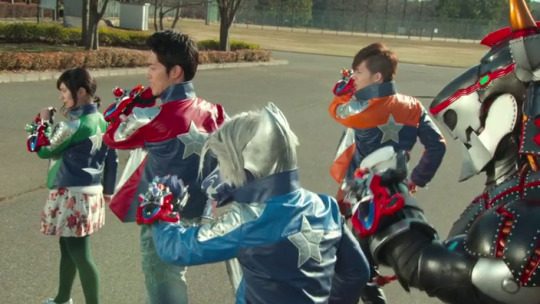
Okay, to be fair, that part is ominous because the Kyurangers are here for Poppy since they think this video game character is linked to other video games attacking reality - I guess since they have a lot of research at their disposal, because they know what Bugsters are!
But just as the Ex-Aid VS Kyuranger stuff begins, it quickly ends once Shishi Red... decides Kamen Riders are heroes because there's a game called Choh Superhero Taisen that Riders and Rangers are both part of. I mean, he's not wrong?
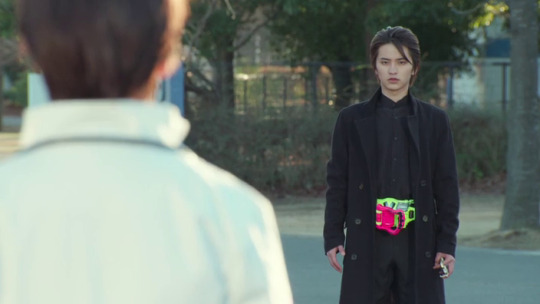
So yeah, that's a thing! Choh Superhero Taisen is a game that’s invaded this world and challenges Ex-Aid. Among its returning Riders/Rangers is an alternate version of Hiro, transforming into Kamen Rider True Brave.
I was VERY interested in learning the backstory of this character - is it an alternate universe thing, or what? Turns out, he's a video game character... and for story reasons, it’s a Hiro who took a different path in life.
It sorta makes sense, I promise.

Things get interesting once Ex-Aid and Poppy enter the world of Choh Superhero Taisen, which is more or less a bunch of Toei's usual filming locations but with returning actors accompanying them!
The first being Kyoryu Gold from Kyoryuger, Utsusemimaru - or Utchy for short. I watched at least half of Kyoryuger so I can appreciate his cameo. He does his Brave Daze thing and he gets some good action.
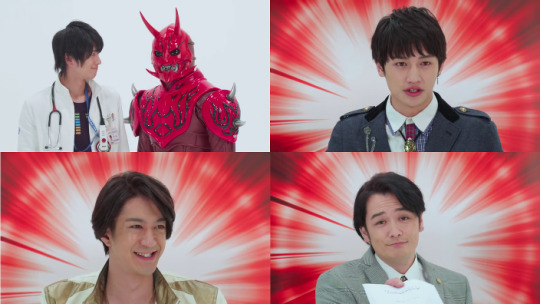
More importantly, you can't have a bunch of returning actors without Toei proving they can somehow keep getting all of the Imagin from Den-O. And I can understand someone being sick of them by now, even if you were a fan before, but the scene where Ex-Aid has to pick his team makes me smile. Although... considering ToQGer's premise, should Urataros really be flirting with one of the girls?
MOVING SWIFTLY ALONG, Emu chooses a "Gorider" team, with Momotaros being Pink - it's a pun. Ex-Aid uses Robot Action Gamer to cheat his way into the Red slot, which I kinda wish someone called him out on.
Ao Ninger makes an easy return as Blue, providing a nice callback to Ninninger as he basically takes charge and tell's Emu to pick his master, Magi Yellow, who taught him magic - but ends up calling Beet Buster from Go-Busters instead, because same actor. That was cute.
Lastly, filling out the team’s Green slot, the out-of-nowhere return of Zolda from Ryuki! I... y'know, it's best they didn't address his cancer since this is supposed to be the "game world" Zolda. Instead, they lean into his lawyer-ness - it felt very appropriate for him to dismiss the Gorider thing and only take part if they signed a contract. I also enjoy how he keeps referring to Momotaros as Goro-chan. It’s cute. I don’t have the heart to tell him Goro is in Zawame.
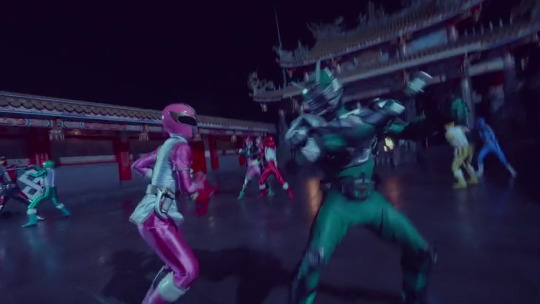
With a team decided upon, this starts to feel like an entirely different movie with Riders VS Rangers. My only gripe here was I could've used at least one more fight. You get a nice tournament chart that shows you all of the different fights happening offscreen, and to be quite honest I needed to see the Dandy team in action.

Right, so I should talk about the kid now. There's a patient Hiro was responsible for, who made the Choh Superhero Taisen game and disappeared afterwards. This is where things get interesting because Hiro has this logic of "I won't perform surgery on a patient unless they want it", which was used well in the show. Hiro presented the kid a chance to be cured, and he said no, so Hiro reluctantly accepted the kid’s choice.
Essentially, Alternate Hiro was made in this kid's game world as a personification of Hiro's guilt, and acts as his aide. It kind of works. But it kind of doesn't? Which is really a good way to describe spring movies as a whole.
However, I dig the alternate Hiro in concept. He isn't an evil version of the character like you'd expect - he has some sense of justice to him, he's protecting this kid after all, it's just that he's wrong in the eyes of the actual Hiro because it conflicts with his own ethics. This may be the best part of the movie, or at least the part with the most depth.
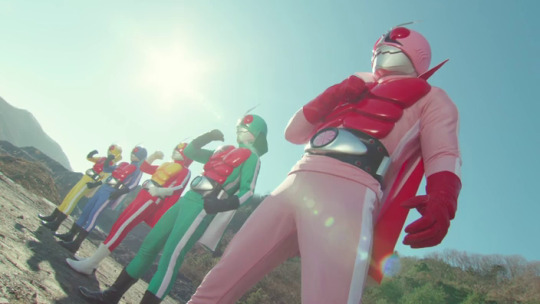
Oh right, so Ex-Aid and the others on his team become Kamen Sentai Gorider... which is a combination of the original Sentai and the original Kamen Rider... and it's about out of place as it sounds.
It feels right at home with all this chaos, I guess. But I don't have much to say about it beyond that. I still gotta watch the actual Gorider special.
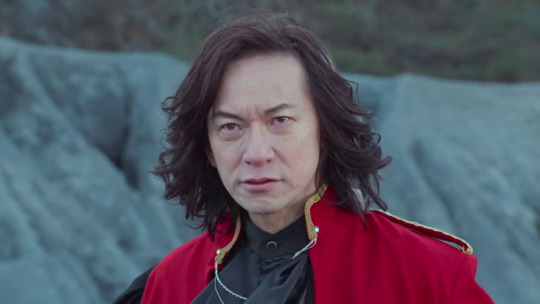
Not a shocker for something to feel out of place in one of these movies. You know what’s also out of place? Shocker! Yes, the original villains are back again, and this time-- they don't have a different name, but I'd like to call them Game Shocker, because it implies they're living on in yet another form.
They also have a new young leader, Shocker Leader III to be exact, which I was admittedly interested in learning more about. The actor made a big deal about how he thinks of Shocker as a group that admires the Kamen Riders, quoted saying "I want you to understand Shocker's feelings".
In all honesty, though, the character doesn't stand out to me as being any different than a generic Rider movie villain, and would have probably been better off in a different movie. A shame too, because I love the idea it sounded like he was hinting at.
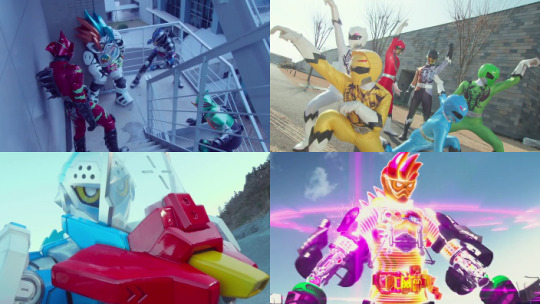
The movie is all over the place, and there's some things I wanna talk about but feel like I don't need to dedicate a whole screencap to. Let's go through these real quick...
Among the many cameos, we get the Kamen Rider Amazons crew, which includes Alpha, Omega and the then-new Neo! I haven't seen Amazons and this cameo taught me... they fight aggressively. I’ll be honest, I really felt nothing from this cameo. But I can appreciate how they added the dramatic lighting Amazons is known for. And Ex-Aid cleverly added some game logic to the fight by looking for a hidden power-up. He probably connects all of the pork chops in Castlevania.
The Zyuohgers make a cameo! That's pretty fun considering this is one show later. Unfortunately this cameo also made me realize Amu really did not have much to do with the story. I legit forgot about her while writing all this.
Brave uses Galaxian Quest Gamer, which wins the award for most pointless and rushed movie form debut. Like, I think he put on the armor and fought some dudes real quick and you never see it again. Galaxian played some part in the game world destruction earlier, but now that I think about it, you could replace that with Shocker to make them fit in better...
To end on a positive note, Ex-Aid uses a special giant Energy Item with Maximum Gamer to grow to Sentai mech size and fight alongside the Kyurangers' mech, which was a very fun visual since it involved a unique transformation in which Ex-Aid grows in size as the armor builds around him. This felt like a "They knew this was cool and wanted to take it a step further" moment.
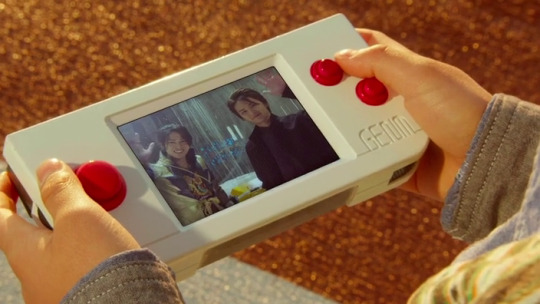
Since I sped through all of that, let's get to the ending.
There's a nice moment with the kid and Naga from the Kyurangers, as they both share the inability to properly express emotions, and I can appreciate how they made use of Naga even if I have little exposure to Kyuranger - that was nice and heartfelt.
Through a combination of Ex-Aid's previous efforts and Brave's current efforts (pretty cool having both of them involved there), the kid is saved, everyone who got sucked into the game world is back out, and the status quo returns to normal.
The credits roll with a nice collection of cards based on all the characters in the movie.
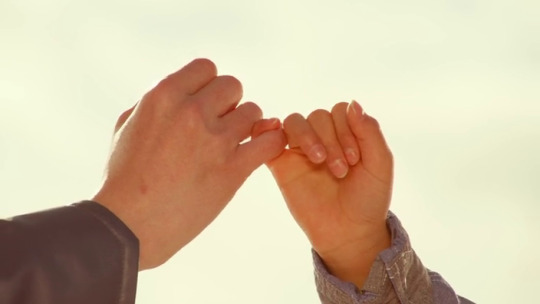
So how did this one turn out? Well, as a movie, pretty awful. As a toku movie, not great. As a Kamen Rider spring crossover movie, it's a'ight I guess? I feel like I'm a lot more forgiving of these than others - even though I'm not opposed to making fun of things like Tsukasa's bad hair day or Space Shocker, I do get something out of these, so that's why I watch them.
With the idea in mind that this is the final spring crossover movie we'll get out of Kamen Rider and Sentai - as the upcoming spring movie is gonna be about Amazons instead and the future beyond that is uncertain - I think they could have ended on a far more typical clusterfuck note. Arguably, they did? But I think among the far-too-many ideas this one had, some of the ideas were good. And for a movie trying to make heroes fight other heroes, it's doing so in a fun way by making use of Ex-Aid’s game motif.
I'm gonna miss these movies. They weren't great, but they were fun eye candy. I'm gonna be interested in seeing what they do with that spring movie slot - will Amazons be the last spring movie entirely, or will it be Toei's go-to for "We just wanna make some kind of thing" movie projects? Only time will tell!
I think you know what comes next, right? I’ve got the first winter movie reviewed, now the spring movie - so obviously spinoff material next. Or the summer movie! Whichever happens first.
9 notes
·
View notes
Text
Aural Assembly: Artistic Statement
Aural Assembly: Echoing Life-Worlds
Interdisciplinary research requires not only the transgression of different fields of study, but can be viewed as the very questioning of the relation of subject and object, self and other, of concept and affect, in the active pursuit of knowledge and understanding.
Pairing the exploration of ephemerality as a way to engage and expand the relationship of interdisciplinarity, with soundscapes in a non-narrative and non-linear style, a podcast can become not only the discussion of a subject by means of words and discourse, but an (albeit short) engagement with relationality and aurality as epistemology itself. Recording soundscapes of our direct environment, pairing these with elements of found sounds, recordings of media or occasional poetics creates the fruitful tension of inference and interferences: at once an argument or idea is carried forward (to infer) in the modes of listening and sense-making as logocentric animals trying to gauge and utilize, to understand and categorize sound; while the idiosyncrasies of sound, its incidental and fleeting nature in the cycles of occurrence, reoccurrence and rhythmic breakages create interferences and epistemic-noise. Aurality that disregards “sense” for the current timespace of listening, unique and again living only in relation of subject and object, turning ephemeral, dissipating once the experiences cease to occur but binding in a transformative mode of kairos.
In creating different “Assignments” the group explored the ability of sound-making and recording as a means to engage with each other's life-worlds. That is, the active and sounding environment of one's own individual hearing and listening (passive/active), shimmering between specificity and everyday similarities. The group’s makeup creates a unique line of interferences/ inferences: taking up the theme of research and life during the CoViD 19 pandemic; listening through different levels of lockdown and protests across the political spectrum; hearing three different countries and through four different sonic approaches; listening to each other and understanding each other stretch over space, positionality and academic backgrounds. This might sound like interference as in a simple game of broken telephone, trying to echo and reiterate common themes and auditory cues, but it also builds a different relation to a shared life-world and mutual aural existence. For instance, we went from childhood memories to experiences of colorism, mothering and loss to political outrage within the span of two creation cycles.
Our aim is not only to create an intimacy within our group and our individual works, but to explore sub themes within the overarching focus on soundscapes during the pandemic, and in so doing resonate with the listeners of the podcast. Taking up these different relationalities, sounds (and soundscapes) as non-verbal communications of lived timespace can bridge the divides between us as powerful actors, creating a living narrative for listeners to follow. The self will always be inscribed in the recordings, incidents and editing might flow apart or together in the listening experiences of the audience, with their own relation being born in the process of encountering the piece at hand. In these movements the idea of static messages becomes alleviated and transformative: the affective nature of sound, the shaping of pure energy paired with the ability to communicate distilled emotion and situatedness via sounds, creates an active knowing for us and the listeners in turn. In creating a cohesive fifteen-minute experience while also enlarging this with our research work in the form of a Tumblr, padlet and soundcloud sites, references and textual resources become available while giving the listeners the agency to deepen and completely transform their own trajectory – giving the possibility to create their personal “podcast” of sorts.
Post-scriptum: in entering the editing process for this 15 min montage, we came upon more than one ethical crisis. What had first been delineated as spaces, started to feel like rifts, then chasms. Questions of collectivity came through in questioning leadership, representativity, agency and choice. What does it mean for us to highlight violence? When does editing out become harsh, brutal even? Are we sublimating dissonance when advocating for unity? What does letting go mean for in fact wanting to hold on, tighter? We spoke louder across these distances, as if asking the same question over again: can you hear me. For some of us this has begun to feel like so much more than a project. It is about life under COVID. It is assembly, and it is dispersal.
What you are listening to is ultimately one take among many.
Subtheme Jayanthan Sriram: Breathing in Times of CoViD
As an academic working on olfaction and the epistemic value of smells, working with sound encompasses the making and disintegration of these relations via ephemerality. Following a modal anthropology as proposed by Francois Laplantine, while olfaction and smelling things break the relation in a mode of internalization, the inextricability of sounding-self and sounding-other(ness), sound and listening perpetuate similar delimitations of hearing and sounding, being in sound, sound itself and dealing with the eventfulness of something that is mostly regarded as the antithesis to knowledge formations of visuality and written language.
The exploration of olfaction via sound becomes an issue of translatability. A common denominator of sound and smell, however, is the air we breathe. The simplicity of an autonomous action, one that builds the very essence of bodily existence, becomes messy and contested during the pandemic and beyond. As protests for Black Lives repeat the dying words of those lives taken by executive force, “I Can't Breathe” turns to the disillusioned notion of those that feel their freedom pressured and their sovereignty questioned by lockdown regulations. Air and the common air we breathe becomes a contested field: The medium of an airborne virus and therefore the probable health hazard, the lived necessity taken by racist actions and the perceived source of defiance against the confines of state regulation and obscure power interested in leaning into conspiracies against white and western supremacy. Can a recording of this struggle for breath make sense of the times, or serve as the mere invitation for understanding the divides that have taken a different turn during a pandemic? Can a moment like the one we are living, that attacks the very nature of relating to one another, bring insight into connections of communities and society that have been under attack all along?
List of audio used:
Spoken excerpt: Wilkerson, Isabel (2020), Caste - The Lies That Divide Us. London: Penguin Books. p. 18.
Excerpts of Anti-COVID Regulation Demos: https://www.youtube.com/watch?v=yr1YyrolRZY (Courtesy of Spiegel TV) and https://www.youtube.com/watch?v=Zf7fRGI_7eo (Courtesy of BILD)
Recordings of Guitar and Voice by Jayanthan Sriram
Excerpt from The Simpsons “Boy-Scoutz´n the Hood” (1993) and “Lisa´s Rival” (1994). Courtesy of FOX.
Excerpt of “Lil Diamond Boy” by Lil Yachty from Lil Boat 3.5 (2020). Courtesy of Capital / Quality Control.
Excerpt of “Many Jewels Surround the Crown” by Prurient from Bermuda Drain (2011). Courtesy of Hydra Head Records.
Excerpt of “Sleeping In” by Jesu from Terminus (2020). Courtesy of Avalanche Records.
Excerpt of “Between The World and Me” (2020), directed by Kamilah Forbes. Courtesy of Warner Media / HBO
Subtheme Amanda Gutierrez: Walking as a collective in Times of CoViD
Voice over:
Judith Butler's text, Gender Politics and the Right to Appear (2015), informed my work about the meaning of collective walking in the public space as a political alliance. In her book, Notes Toward a Performative Theory of Assembly, she exposes the concept of "we" as a collective body that spatially voices the challenges of exclusion that have been experienced under conditions of oppression. For Butler, the performative action of taking public space as an act of resistance and solidarity reads as follows:
Each "I" brings the "we" along as he or she enters or exits that door, finding oneself in an unprotected enclosure or exposed out there on the street. We might say that there is a group, if not an alliance, walking there, too, whether or not they are anywhere to be seen. It is, of course, a singular person who walks there, who takes the risk of walking there, but it is also the social category that traverses that particular gait and walk, that singular movement in the world; and if there is an attack, it targets the individual and the social category at once. (2015, p. 51-52)
Thus, the idea of "walking with with" is a crucial tool for collective recognition and a performative act of enunciation, an act of speech that we can exercise in space. As a filmmaker, the virtual space could be an extension of the public space, an intersection that I am trying to find in these soundscapes.
However, how can we do it from the interior of our houses? Keeping us safe from being infected by a virus?
I did this performative exercise, please join me interacting with the sound:
Experiment on aural performance, can be heard in the minute 12:17 on the soundtrack.
Subtheme Koby Rogers Hall: Life and Death in Reproductive Labour
In the seminal book Mapping Vulnerability: Disasters, Development and People, the authors argue for an interpretation of disaster as a complex process that is socially, politically, environmentally and economically constructed, as opposed to an event caused by an external agent (Bankoff, Frerks & Hilhorst, 2013). Correspondingly, the concept of “structural vulnerability” is used within the social sciences as a method to analyze the varying capacities of communities to deal with hazards, based on their social positionality; vulnerabilities result from an individual’s position within local hierarchies and broader power relationships. This approach to vulnerability differs greatly from others that seek to naturalize an individual’s ability to cope as a result of internal causes.
(Henaway, 2020)
MY WORKING WILL BE THE WORK.
- Mierle Laderman Ukeles, Manifesto for Maintenance Art
The soundscapes work of the past four months has been an experiment in sounding, listening, and wondering, of being heard in a time of being unseen. As Dwayne Donald (2012) unravels in his work on a decolonizing research sensibility, our stories are held in tension as they display relationality and difference around difficult concerns. “The line which a story follows is not straight, logical, step by step. It varies from life to life. Most often, it zigzags, as if seeking out the spot for a breakthrough” (Novak, 1978, p.53).
In this year since my first child’s birth, a year of pandemic, of public outcry, of climate crisis on an ever-consuming scale, the violence of inequities for those of us who recognise them well have been forced to the forefront of our being. They say this economic crisis is ‘different’, in that it will set mothers back a generation between care work and the loss of any employment gains (Cohen, 2020; Adams-Prassl, 2020). As I do another load of diapers in what is essentially a broken laundry machine – having been asked to bear far beyond its load capacity - I am reminded of how my dreams of late feel so disjointed, and that disruption feels so familiar. “Everything I say is art is art. Everything I do is Art is Art.” (Ukeles, 1969, p.2).
The rage in the quietude is palpable. And so in sounding with my colleagues across locations, in conversing across ‘tasks’ we have given each other, I see the juxtaposition of our daily reproductive lives and labour. There are gaps between two sounds, two spaces, and we are left to negotiate in relation to this empty space. We are asked to “hold these understandings in tension without the need to resolve, assimilate, or incorporate” (Donald, 20102, p.534). The distances I feel from the people I organise with are felt stronger and stronger every day – mothering and organising, worker and consumer, the privilege of working and so feeling remotely. These distinct fields are not only removed from one another, but they further vulnerabilise us, structurally, by making the vast expanses already between us viscerally clear. When Judith Butler asks if precarity can be a unifying force, what do we risk losing in this assumption of unity? What are these soundscapes ‘trying to do’, if not be seen, then heard? Are we, am I, in fact grievable? (Butler, 2015, p.47).
A distanced visit with a friend and organiser tells me of ‘essential workers’, immigrant and migrant workers, demonstrating daily during the pandemic because they have to. In their words, “I have to be here, otherwise people will let me die.” (Henaway, in conversation, June 2020). Linda Tuhiwai Smith asserts that we need to think of research methodology as resistance, “a thoughtful engagement with these contradictions by providing a way to plan, conceptualize, strategize, and make cogent various forms of resistance to the logic of colonialism.” (1999, p.38) For those of us who are made to feel expendable, the ones who show up when the shit hits the fan, we know who we are – this is a moment of dignity and overflowing rage. With death comes endings, and as the contours of this world face their own forms of decay, there are those of us at the edges who find comfort in this, knowing that we breathe life anew.
Sub-theme Raphaëlle Bessette-Viens: feeling around
“What does your life sound like?” I asked you. “It sounds a bit like this, here, listen …” And when we listened to each other I felt my boredom, anxiousness and loneliness was shared. Some of us thought it was an ideal period to work, others felt too dispersed to concentrate properly. Micro social spheres; partners, children. A few times we shared being surrounded by collective appearing bodies; some skeptical or paranoid when they disbelieved the existence of the virus, some out of collective outrage when black bodies continued being assaulted by police officers.
Fear. Around me concern for sustaining life amidst an overwhelmed medical system co-exists with the perpetuation of fear of the ‘stranger’ (Ahmed, 2014): police violence, the criminilization of anti-islamophobic organisations, the expulsion and chasing of undocumented persons into invisibility. Being inside, feeling non-apparent. The aggregation of bodies that collect together in order to state their existence (Butler, 2015), to which I belong to, is in intermission. Spilling over. There was a protest and I saw all those familiar faces I hadn't seen in a while and walked and screamed and sang with them. Anger and happiness overlapped.
Affective contagion (Stewart, 2007, p.16). When I heard you say you were feeling anxious, and that you were having a hard time with distanced communication, it made me feel it was okay to say it too. I edited-in my piece that I gave back to you, to signify it. Did you hear it? Echoing. “... hmm that reminds me of”; the surfacing of a thought or a memory. Hearing your child made me think of me as a child and then I learned about your childhood. I heard the sounds of our bodies in our confined spaces, in relation with others in this space, in relation with the exterior world by mediation, being called-in to your world with your voices. Our echoes felt like intimate refrains: “(…) repetition that underscores, overscores, rescores in a social aesthetics (…)” (Stewart, 2010, p.339). We worked together, as Guattari suggests, with ways closer to the ethico-aesthetic than of scientificism (1995). Aggregating, week after week, our soundscapes and our thoughts, we practiced our attunement to one another, to our collective. “What does your life sound like right now?”
List of references
Adams-Prassl, A., Boneva, T., Golin, M., Rauh, C. (2020). Inequality in the Impact of the Coronavirus Shock: Evidence from Real Time Surveys. Cambridge-INET Working Paper Series, (18)
Ahmed, S. (2014). The Cultural Politics of Emotion (2nd ed.). Edinburgh: Edinburgh University Press.
Bankoff, G., Frerks, G., Hilhorst, D. (Eds.). (2013). Mapping Vulnerability: Disasters, Development and People. New York: Routledge.
Bertelsen, L., Murphie, A. (2010). An ethics of everyday infinities and powers: Felix Guattari on affect and the refrain. In Gregg, M., J. Seigworth, G. (Eds.). The affect theory reader (1st ed. pp. 138-157). London and Durham: Duke University Press.
Butler, J. (2015). Gender politics and the right to appear. In Notes Toward a Performative Theory of Assembly (pp. 24–65). Cambridge, MA: Harvard University Press.
Cohen, P. (2020, Nov. 19). Recession with a Difference: Women Face Special Burden. New York Times. Retrieved from https://www.nytimes.com/2020/11/17/business/economy/women-jobs-economy-recession.html
Donald, D. (2012). Indigenous Métissage: a decolonizing research sensibility. International Journal of Qualitative Studies in Education, 25(5), 533-555.
Guattari, F. (1995). Chaosmosis: An Ethico-Aesthetic Paradigm (Bains, P., Pefanis, J., Trans.) Sydney: Power. (Original work published 1992)
Jenkins, H., Ford, S., Green, J. (2013). Spreadable Media: Creating Value and Meaning in a Networked Culture. New York: NYU City Press.
Henaway, M. (2020). The Borders that Define our Vulnerability. Terms, semi-annual program. Leonard & Bina Ellen Art Gallery, Concordia University. http://ellengallery.concordia.ca/programming/online/terms/?lang=en
Howes, D. (2003). Sensual relations. Engaging the senses in culture and social theory. Ann Arbor: University of Michigan Press.
Howes, D. (ed.) (2005). Empire of the senses. The sensual culture reader. Oxford & New York: Berg.
Laplantine, F. (2015). The life of the senses, Introduction to a modal anthropology (Furniss. J. Trans.). London: Bloomsbury. (Original work published 2005)
Novak, M. (1978). Ascent of the mountain, flight of the dove: An invitation to religious studies. New York: Harper & Row.
Reynolds, S. (2011). Retromania. Pop culture's addiction to its own past. London: Faber and Faber Ltd.
Smith, L.T. (1999). Decolonizing methodologies: Research and Indigenous peoples. Dunedin, New Zealand: University of Otago Press.
Stewart, K. (2007). Ordinary affects. London and Durham: Duke University Press.
Stewart, K. (2010). Afterword, Worlding refrains. In Gregg, M., J. Seigworth, G. (Eds.). The affect theory reader (1st ed. pp. 339-353). London and Durham: Duke University Press.
Ukeles, M.L. (1969). Manifesto for maintenance art, 1969! Proposal for an exhibition: “care”, 1969.
Voegelin, S. (2010). Listening to sound and silence. Towards a philosophy of sound art. London, New York: Continuum.
0 notes